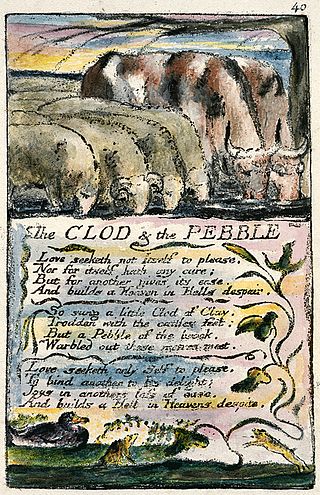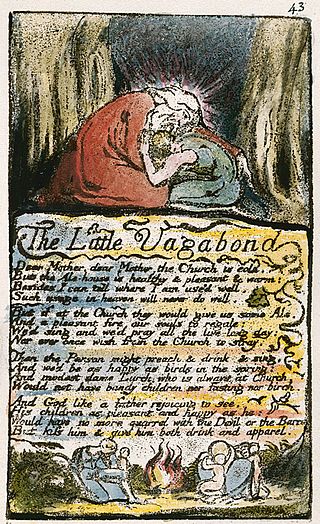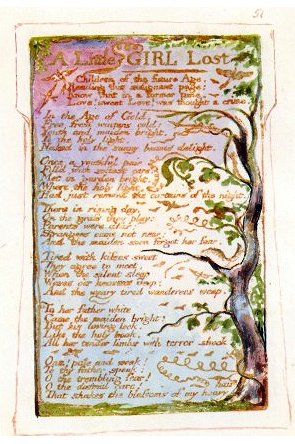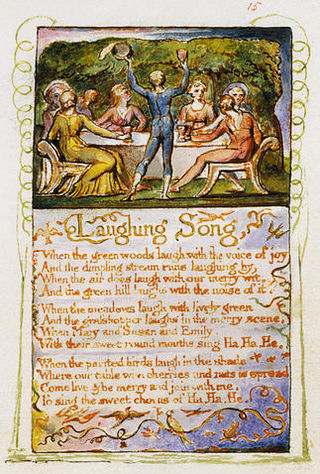Spring is a lyric poem written and illustrated by William Blake. It was first published in Songs of Innocence (1789) and later in Songs of Innocence and Experience (1794).
Contents


Spring is a lyric poem written and illustrated by William Blake. It was first published in Songs of Innocence (1789) and later in Songs of Innocence and Experience (1794).


William Blake's Songs of Innocence (1789) is a lyric anthology that consists of nineteen illuminated poems. Each poem is accompanied with an illustration by Blake. Songs of Innocence was later combined with Blake's Songs of Experience in 1794 to make Songs of Innocence and Experience, and were printed combined as well as separately. [1]
Sound the Flute!
Now it's mute.
Birds delight
Day and Night.
Nightingale
In the dale
Lark in Sky
Merrily
Merrily Merrily to welcome in the Year
Little Boy
Full of joy.
Little Girl
Sweet and small,
Cock does crow
So do you.
Merry voice
Infant noise
Merrily Merrily to welcome in the Year
Little Lamb
Here I am,
Come and lick
My white neck.
Let me pull
Your soft Wool.
Let me kiss
Your soft face.
Merrily Merrily we welcome in the Year. [2]
The poem is split into three stanzas. The rhyme scheme goes AABBCCDDE. The last line of each stanza is the same to show the joy the author has for this time of year. The poem is written in dactylic feet. There are several reference's to other poems or characters from Blake's "Songs of Innocence." For example, the introduction of this poem speaks of the flutist, which comes from several of Blake's poems and is illustrated on the front piece for Songs of Innocence. The poem refers The Little Boy, from the poems "The Little Boy lost" and "The Little Boy found". The Little Girl, who appears in several poems in Songs of Experience is mentioned.. The poem also references the Lamb, from the poem "The Lamb". Together Blake incorporates these characters into a happy poem welcoming Springtime, which marks the beginning of a new year for them. [3]
"Spring" is a happily written poem with a hint of rhyme. Devoted to Blake's favorite things, each stanza describing a particular thing. The first stanza is about birds and a bush, the second a little boy and a little girl, and in the final stanza the lamb and "I". [3] This format shows the transition from innocence to a bit of romance, where the child and lamb become close. They share a touch and a kiss in this stanza, and the final line changes from the first two stanzas. With only a single word change, going from "to" to "we", representing the growth of the characters, and how they deviate from the "innocent" title given to them.
In Songs of Innocence several of the poems seem to be linked closely together. Scholars typically associate Spring with "The Echoing Green" due to fourth line in the first stanza "To welcome the Spring,". [3]

"The Tyger" is a poem by the English poet William Blake, published in 1794 as part of his Songs of Experience collection and rising to prominence in the romantic period. The poem is one of the most anthologised in the English literary canon, and has been the subject of both literary criticism and many adaptations, including various musical versions. The poem explores and questions Christian religious paradigms prevalent in late 18th century and early 19th century England, discussing God's intention and motivation for creating both the tiger and the Lamb.

"The Lamb" is a poem by William Blake, published in Songs of Innocence in 1789.

"The Chimney Sweeper" is the title of a poem by William Blake, published in two parts in Songs of Innocence in 1789 and Songs of Experience in 1794. The poem "The Chimney Sweeper" is set against the dark background of child labour that was prominent in England in the late 18th and 19th centuries. At the age of four and five, boys were sold to clean chimneys, due to their small size. These children were oppressed and had a diminutive existence that was socially accepted at the time. Children in this field of work were often unfed and poorly clothed. In most cases, these children died from either falling through the chimneys or from lung damage and other horrible diseases from breathing in the soot. In the earlier poem, a young chimney sweeper recounts a dream by one of his fellows, in which an angel rescues the boys from coffins and takes them to a sunny meadow; in the later poem, an apparently adult speaker encounters a child chimney sweeper abandoned in the snow while his parents are at church or possibly even suffered death where church is referring to being with God.

"The Echoing Green" is a poem by William Blake published in Songs of Innocence in 1789. The poem talks about merry sounds and images which accompany the children playing outdoors. Then, an old man happily remembers when he enjoyed playing with his friends during his own childhood. The last stanza depicts the little ones being weary when the sun has descended and going to their mother to rest after playing many games.

Songs of Innocence and of Experience is a collection of illustrated poems by William Blake. Originally, Blake illuminated and bound Songs of Innocence and Songs of Experience separately. It was only in 1795 that Blake combined the two sets of poems into a volume titled Songs of Innocence and of Experience Shewing the Two Contrary States of the Human Soul. Even after beginning to print the poems together, Blake continued to produce individual volumes for each of the two sets of poetry.

"The Little Black Boy" is a poem by William Blake included in Songs of Innocence in 1789. It was published during a time when slavery was still legal and the campaign for the abolition of slavery was still young.

"The Blossom" is a poem by William Blake, published in Songs of Innocence in 1789.

Earth's Answer is a poem by William Blake within his larger collection called Songs of Innocence and of Experience. It is the response to the previous poem in The Songs of Experience-- Introduction . In the Introduction, the bard asks the Earth to wake up and claim ownership. In this poem, the feminine Earth responds.

"The Clod and the Pebble" is a poem from William Blake's 1794 collection Songs of Innocence and of Experience.

The Little Girl Lost is a 1794 poem published by William Blake in his collection Songs of Innocence and of Experience. According to scholar, Grevel Lindop, this poem represents Blake's pattern of the transition between "the spontaneous, imaginative Innocence of childhood" to the "complex and mature adult state of Experience."

The Little Vagabond is a 1794 poem by English poet William Blake in his collection Songs of Innocence and of Experience. His collection, Songs of Innocence, was originally published alone, in 1789. The scholar Robert Gleckner says that the poem is a form of transformation of the boy in the poem "The School Boy", from Songs of Innocence.

"Infant Joy" is a poem written by the English poet William Blake. It was first published as part of his collection Songs of Innocence in 1789 and is the counterpart to "Infant Sorrow", which was published at a later date in Songs of Experience in 1794.

"The Shepherd" is a poem from William Blake's Songs of Innocence (1789). This collection of songs was published individually four times before it was combined with the Songs of Experience for 12 editions which created the joint collection Songs of Innocence and of Experience (1794). Blake produced all of the illuminated printings himself beginning in 1789. Each publication of the songs has the plates in a different order, and sixteen other plates were published posthumously.

"A Little Girl Lost" is a poem written by the English poet William Blake. It was first published as part of his collection Songs of Innocence and of Experience in 1794. The poem is written as a clear authorial commentary from Blake, focusing on the tension between human passions and societal expectations.

The Voice of the Ancient Bard is a poem written by the English poet William Blake. It was published as part of his collection Songs of Innocence in 1789, but later moved to Songs of Experience, the second part of the larger collection Songs of Innocence and of Experience, 1794.
"Night" is a poem in the illuminated 1789 collection Songs of Innocence by William Blake, later incorporated into the larger compilation Songs of Innocence and of Experience. "Night" speaks about the coming of evil when darkness arrives, as angels protect and keep the sheep from the impending dangers.

"The Little Boy Found" is a poem by William Blake first published in the collection Songs of Innocence in 1789. Songs of Innocence was printed using illuminated printing, a style Blake created. By integrating the images with the poems the reader was better able to understand the meaning behind each of Blake's poems.

"The Little Boy Lost" is a simple lyric poem written by William Blake. This poem is part of a larger work titled Songs of Innocence which was published in the year 1789. "The Little Boy Lost" is a prelude to "The Little Boy Found".

"Laughing Song" is a poem published in 1789 by the English poet William Blake. This poem is one of nineteen in Blake's collection Songs of Innocence.

"The School Boy" is a 1789 poem by William Blake and published as a part of his poetry collection entitled Songs of Experience. These poems were later added with Blake's Songs of Innocence to create the entire collection entitled "Songs of Innocence and of Experience Shewing the Two Contrary States of the Human Soul". This collection included poems such as "The Tyger", "The Little Boy Lost", "Infant Joy" and "The Shepherd". These poems are illustrated with colorful artwork created by Blake first in 1789. The first printing in 1789 consisted of sixteen copies. None of the copies of Songs of Innocence are exactly alike as some of them are incomplete or were colored in posthumously "in imitation of" other copies.